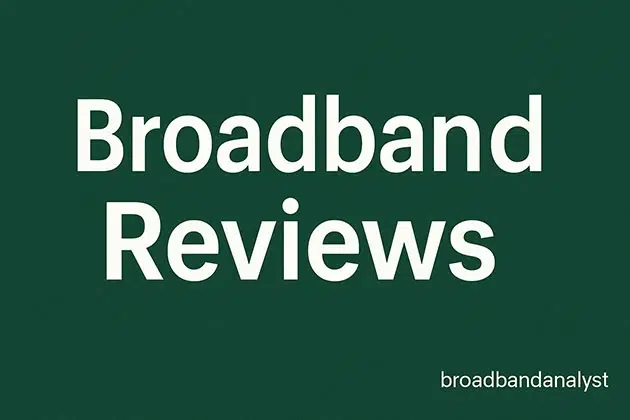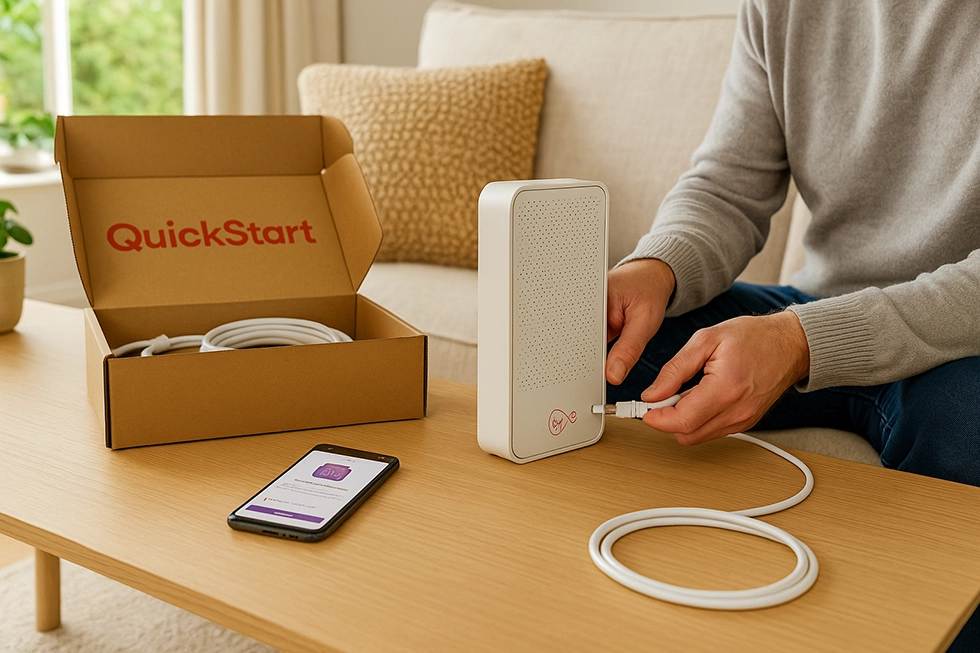Hyperopic broadband review 2025
Hyperoptic is one of the few UK providers that builds and runs its own full fibre network. Unlike most competitors that still rely on copper lines for part of the connection, Hyperoptic delivers fibre-to-the-premises (FTTP) all the way into the home. This means faster and more consistent speeds, plus the benefit of symmetrical upload and download performance.
With plans ranging from 30Mbps to 1Gbps, Hyperoptic is a strong option if you want ultrafast, low-latency broadband. Its focus is mainly on cities, apartment blocks, and new developments, which is where its network has been deployed.
This review takes you through Hyperoptic’s pricing, speed performance, routers, reliability, installation, customer service, and how it compares with other UK broadband providers. The main things that set Hyperoptic apart are its symmetrical speeds, its no mid-contract price hike policy, and its contract flexibility.
| Plan | Speed | Price | |
|---|---|---|---|
 150Mb Fibre 150Mb Fibre12 month contract |
159Mb avg |
£21.99 / month £263.88 / year More details |
|
| FTTP. Free Setup. Reduced price. | |||
 500Mb Fibre 500Mb Fibre24 month contract |
526Mb avg |
£25 / month £300 / year More details |
|
| FTTP. Free Setup. Reduced price.. | |||
 1Gb Fibre 1Gb Fibre24 month contract |
900Mb avg |
£24 / month £288 / year More details |
|
| FTTP. Free Setup. Reduced price. |
Enter your postcode to compare all deals
Who Should Choose Hyperoptic?
Hyperoptic is ideal for gamers and streamers who need low latency, for remote workers who upload large files, and for households that want flexibility without worrying about price increases.
It’s not the best option if you live outside its coverage or want a landline. In those cases, BT Full Fibre, Virgin Media, or Sky may be better alternatives. But if you are within its footprint, Hyperoptic is one of the strongest broadband choices available in 2025.
Pros & Cons of Hyperoptic
Hyperoptic has clear benefits: symmetrical speeds, no mid-contract price rises, low latency, flexible contracts, and fewer complaints than major competitors.
Its drawbacks are just as clear: limited availability, installation delays for new installs, and no landline service.
Hyperoptic Broadband Plans
Hyperoptic offers four main packages, all symmetrical – so the upload speed is the same as the download. That makes it ideal for gaming, cloud storage, video calls and streaming.
The entry plan is Fast 50, offering average speeds of 50Mbps up and down. This plan is fine for smaller households where usage is light: browsing, social media, and standard-definition streaming.
Superfast 150 increases speeds to 150Mbps. This level comfortably handles HD streaming, video conferencing, and multiple devices at once without much effort. It’s a good balance between affordability and performance for a typical family.
Ultrafast 500 takes things further with 500Mbps up and down. This suits larger households with multiple TVs, smart home setups, or those who stream 4K regularly and download large files. Gamers will also benefit from its fast and consistent performance.
The top plan is Hyperfast 1Gbps. At a gigabit, this is designed for busy households with lots of devices and users. It can manage 4K and even 8K streaming without buffering, plus fast game downloads and ultra-quick uploads for creative work.
Contract Options
Hyperoptic’s contract structure is one of the simplest in the UK. You can choose a rolling monthly deal, which costs more but lets you leave at any time. A 12-month contract is available at a lower monthly price, offering flexibility without a long tie-in. The best value is on the 24-month plan, which locks in the lowest monthly price.
This flexibility stands out compared to most other major providers, where contracts typically last 18 or 24 months and monthly rolling options are rare.
Hyperoptic Routers – Hyperhub and Hyperhub+
Hyperoptic supplies two routers, depending on the plan.
The Hyperhub is a Wi-Fi 5 router that comes with the 50Mbps and 150Mbps plans. It offers dual-band Wi-Fi, four gigabit Ethernet ports, and 3x3 MIMO technology to improve coverage and signal strength. It’s sufficient for small to medium homes on entry or mid-range speeds.
The Hyperhub+ is a Wi-Fi 6 router, included with the 500Mbps and 1Gbps plans. It’s better suited for larger homes and households with many connected devices. With dual bands, four gigabit Ethernet ports, and 4x4 MIMO technology, it can handle heavy usage while maintaining strong coverage.
By pairing the appropriate router with each plan, Hyperoptic ensures that customers can take advantage of the speeds they’re paying for.
Installation & Setup
If your building is already wired for Hyperoptic, setup is quick and straightforward. For new installations, an engineer visit is required and the process can take one to three weeks.
Installation is free for 12-month and 24-month contracts. If you go for the rolling monthly option, there’s a £29 installation fee. Hyperoptic doesn’t currently allow self-installation, even where its network is already in place. This ensures every line is tested by an engineer before you start using it, which reduces the risk of performance issues.
Speed & Real-World Performance
One of Hyperoptic’s biggest strengths is consistent speed delivery. Because it is a full fibre network, speeds are much less affected by peak times compared to copper-based connections.
On the 50Mbps plan, speeds often exceed the headline figure in independent tests. In the morning, downloads can reach 152Mbps and uploads 149Mbps. Even in the evening, speeds remain strong at 145Mbps and 143Mbps.
The 500Mbps plan also performs very well, delivering over 500Mbps during the morning and holding around 480Mbps in the evening. That makes it more than capable of handling UHD streaming and gaming across multiple devices at once.
The 1Gbps plan comes close to its advertised figure, with tests showing 975Mbps down and 972Mbps up in the morning, dropping slightly to 930Mbps and 925Mbps during peak evening hours. That level of consistency makes it one of the best consumer-grade gigabit services available.
Latency & Gaming Performance
Latency is particularly important for gaming, video calls and other real-time applications. Hyperoptic’s fibre network offers one of the lowest latency figures in the UK, averaging between 4ms and 8ms.
For gamers, this provides a clear advantage. Games that require split-second reactions benefit from such low latency, and it also ensures smooth performance on video calls and online collaboration tools. Virgin Media and BT typically measure higher latency levels, which means Hyperoptic stands out in this area.
Reliability
Reliability is another area where Hyperoptic scores well. Ofcom’s broadband complaints report shows Hyperoptic with only 5 complaints per 100,000 customers. That’s lower than most major providers, including BT, Virgin Media, Sky and TalkTalk.
This suggests fewer issues with both service quality and customer support. Sky comes close with 6 complaints per 100,000, while Virgin Media records 16 and TalkTalk 18. Hyperoptic’s lower figure reflects a more reliable and consistent customer experience.
Customer Service & User Feedback
Customer service is available 24/7 by phone, with live chat on the website during business hours. Support is also offered via email and social media, plus an online help centre and community forum.
Feedback from users often highlights Hyperoptic’s fast and consistent speeds, the lack of mid-contract price increases, and good levels of customer support. On the downside, some customers mention limited coverage outside major cities and longer installation times for new connections.
Hyperoptic vs Other Providers
Hyperoptic competes with big names like Virgin Media, BT, Sky and TalkTalk. The biggest difference is its symmetrical speeds. Most providers offer much slower uploads compared to downloads, which makes tasks like cloud backups, large file transfers or video uploads harder.
Virgin Media offers faster download speeds on paper, up to 1.1Gbps, but uploads are far slower. BT and Sky use the Openreach network, where speeds are improving but uploads still lag behind. TalkTalk is competitive on price but records more customer service complaints.
Hyperoptic’s packages, ranging from 50Mbps to 1Gbps, with symmetrical performance, are competitively priced and start from £17 per month. Contract flexibility is also stronger than most rivals.
Final Verdict
Hyperoptic is one of the best broadband options available if you live in its coverage area. Its symmetrical upload and download speeds, no mid-contract price rises, and flexible contract options make it particularly appealing for gamers, remote workers, and streaming households.
The biggest drawback is availability, which is still limited to urban areas and new developments. Installation can also take up to three weeks, which isn’t ideal if you need broadband urgently. There’s no landline option either, which may be an issue for some households.
If coverage isn’t a problem, Hyperoptic offers excellent performance for the price. With consistent speeds, low latency, and strong customer support, it’s one of the most reliable broadband choices on the market.

